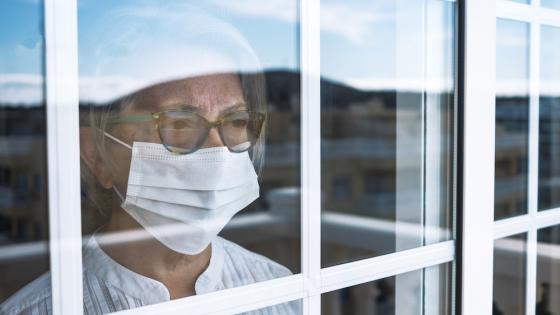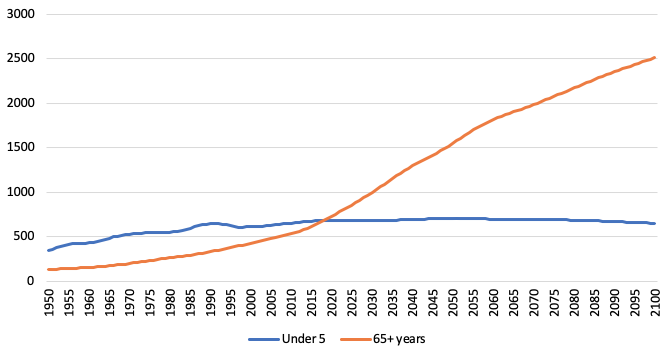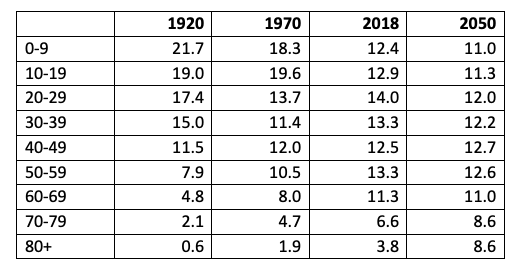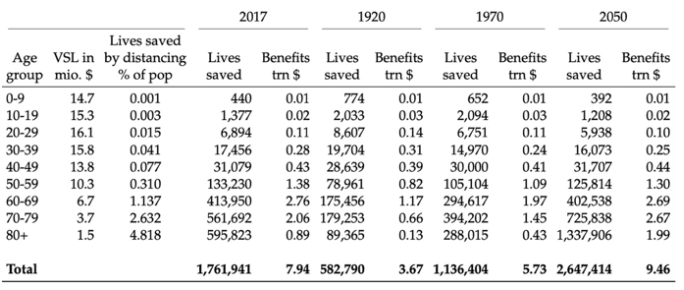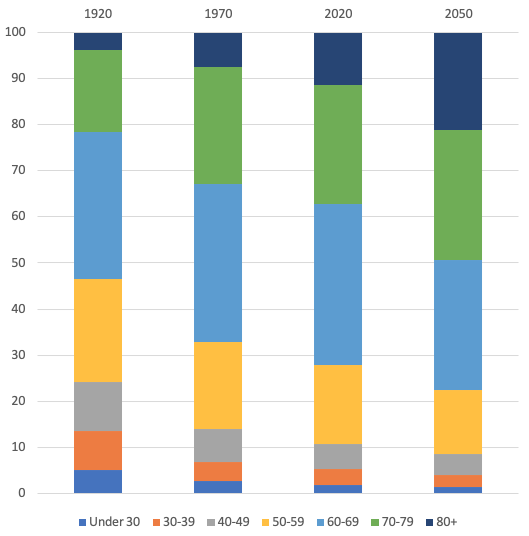Coronavirus has forced many of us to go scrambling back to the history books to see what lessons can be learnt from the Great Influenza Pandemic of 1918-20 (Barro et al. 2020). However, there is a striking way in which Covid-19 as a pandemic is historically unprecedented. As shown in Figure 1, in 2018, for the first time in history, the number of people alive over 65 was larger than the number under five. Because the fatality rate from Covid-19 rises sharply with age (Ciminelli and Garcia-Mandico 2020), this has hugely important consequences for how the pandemic spreads, how many people will die and what the economic response should be. It genuinely is a case of ‘this time it’s different’.
Figure 1 Changes in age structure of global population (millions)
Source: UN World Population Statistics
Table 1 shows the age distribution of the US in 1920 (the end of the Great Influenza Pandemic), 1970, 2020 and projections for 2050. In 1920, 7.5% of the population were over 60. That had roughly doubled (14.6%) by 1970, tripled by 2018 (21.7%) and by 2050 is expected to have quadrupled (28.2%). The proportion of the population over 80 has risen even more dramatically (from 0.6% in 1920 to 1.9% by 1970, then to 3.8% by 2018) and is expected to reach 8.6% by 2050.
Table 1 Age distribution (%) of US population, 1920-2050
Source: US Census and UN World Population Statistics
Ageing societies dramatically change the gains from social distancing
The first implication of this changing age structure is dramatic changes in the proportion of people at risk from Covid-19. Using estimates from Ferguson et al. (2020), on the basis of unchanged policies and behaviour, Covid-19 was estimated to lead to 2.2 million direct deaths in the US. To consider the effects of an ageing society on this outcome, we hold constant the total population at its current level (322 million) and assume the same age specific fatality rates but investigate changing the age distribution of the population. Assuming the age distribution of 1920 reduces the number of deaths to 740,000 whilst using 1970 data, deaths would be at 1.4 million. Based on the 2050 numbers, it would be a staggering 3.4 million.
Because an ageing society means more deaths resulting from Covid-19, it also implies that the health benefits of social distancing increase with an ageing society. To see this, consider an extension of the analysis of Greenstone and Nigam (2020) to calculate how many lives moderate social distancing saves as the age structure of the US is changed. For this exercise, we consider both direct deaths and ‘overflow deaths’ – people who die because of lack of access to intensive care once ICU beds are fully occupied.
As shown in Table 2, the same social distancing measures would save ‘only’ 583,000 lives today if the age distribution were that of 1920, compared to 1.8 million based on today’s distribution. Fast forward to the 2050 numbers and social distancing would save 2.7 million lives. Given the ageing of society, we can therefore expect social distancing to become an ever more vital and prevalent measure during future pandemics.
Table 2 Estimates of loss of life and gains from social distancing under different age distributions
Source: Greenstone and Nigam (2020) and author’s calculations
Greenstone and Nigam (2020) use the value of a statistical life (VSL) to estimate the monetary value of these lives saved. The VSL is defined as the amount society should be prepared to pay to save one ‘statistical’ life. Updating US government (EPA) estimates of VSL, Greenstone and Nigam arrive at $11.5 million for the average adult VSL. Crucially, VSLs decline with age – older people have fewer years of life and these years are on average in poorer health, and so by this calculus they have lower VSLs.
Using these VSLs, we can estimate the monetary value of lives saved from social distancing. Based on the age distribution of society today Greenstone and Nigam arrive at $7.9 trillion (38% of US GDP). However, using the 1920 age distribution (but the 2020 total population), these gains would be $3.7 trillion. In other words, with fewer old people, the 1920 age structure would support shutdowns only half as long. Based on the 1920 population structure, it would be worth closing down the entire economy for two months to achieve the gains from social distancing, based on 1970 data just over three months, based on today’s distribution around four and a half months, and in 2050 just over five months.
Longer lives also make the costs of pandemics greater
It isn’t just the number of older people alive that makes the gains from social distancing so much larger; it is also that people are living for longer and, on average, in better health. In 1920 the average US 65-year old had around 12 years of life left, whereas today they have around 20 years. The consequence of this longevity is that the VSL associated with each age is increasing.
This ‘longevity dividend’ serves to further increase the economic benefits of social distancing. Figure 2 shows how adjusting for longevity accentuates the pattern found above. If we assume the age structure and mortality rates of 1920, the economic value of gains from social distancing are further reduced to $2.7 trillion. Longer lives and more old people mean that the US should be prepared to accept social distancing for three times longer than would previously have been the case ($7.9 trillion/$2.7 trillion). In turn, increased longevity increases the benefits of social distancing in 2050 by an additional $2.2 trillion.
Figure 2 Economic benefits of social distancing decomposed ($ trillion)
Source: Greenstone and Nigam (2020) and own calculations
Intergenerational implications
It isn’t just the gains from social distancing that are different, but also who receives them. As shown in Figure 3, an ageing society means a higher proportion of the gains from social distancing going to older age groups. Using a 1920 age structure, those aged over 70 would account for 22% of the benefits, whereas today it is around a third and by 2050 it will have risen to more than 50%.
Figure 3 Percentage distribution of gains from social distancing by age group
Source: Greenstone and Nigam (2020) and author’s calculations
That leads to greater intergenerational tensions in responding to pandemics because, whilst the gains from social distancing accrue increasingly to the old, estimates suggest the economic costs of shutdown are borne disproportionately by the young (Joyce and Xu 2020).
It is important, however, not to overstate the degree of these intergenerational tensions. The young and the old are part of the same families and often the same households. Many of the countries who have been most severely hit by Covid-19, such as Italy, have been affected precisely because of high levels of intergenerational mixing.
It is also important to recognise that the young and old are not an eternally divided group. Eventually the young become the old. In fact, the chances of that happening are a lot greater now than they used to be. Back in 1920, a 20-year old American had a 50% chance of making it to 70; today that number is over 80%. Because of increases in life expectancy, a 20-year old today should be much more interested in how society looks after the health of 70-year olds in response to a once in 50 years pandemic than they would have been in 1920.
Of course, this doesn’t mean policymakers should ignore these intergenerational issues. Ensuring policy measures target supporting the young, both now and post Covid-19, is essential, especially for those just leaving college and entering the labour market. One way to do this is that as social distancing measures are removed to give priority to younger workers returning first. With over 10 million US workers aged over 65, this phased approach to ending social distancing will help minimise both the economic and public health costs.
Conclusion
An ageing society makes pandemics such as Covd-19, where fatality rates increase sharply with age, dramatically more costly in terms of loss of live. As a consequence, the gains from social distancing and the associated size of economic recession (Gourinchas 2020) that is acceptable both increase. Clearly a greater cost from pandemics requires greater investment in the medical capacity required to fight them (intensive care beds, ventilators, etc.). It also requires greater investment in improving how societies age. Whilst the mortality rate of Covid-19 increases with age, it isn’t chronological age per se that is the main problem but the associated increase in underlying health conditions such as heart disease, cancer, diabetes, and so on. Focusing on health measures and research which successfully slows down the rate of biological ageing is paramount if society is to fully exploit the enormous increases in life expectancy achieved over the last 100 years. It will also be crucial if we are to minimise the costs of future pandemics that will occur over these longer lives.
References
Barro, R, J Ursua and J Wenig (2020), “Coronavirus meets the Great Influenza Pandemic”, VoxEU.org, 20 March.
Bayer, C and M Kuhn (2020) “Intergenerational ties and case fatality rates : A cross-country analysis“,
Cimenlli, G and S Garcia-Mandico (2020), “COVID-19 in Italy: An analysis of death registry data”, VoxEU.org, 22 April.
Ferguson, N M et al. (2020), “Impact of non-pharmaceutical interventions (NPIs) to reduce COVID- 19 mortality and healthcare demand”, Imperial College COVID-19 Response Team.
Gourinchas, P-O (2020), “Flattening the pandemic and recession curves” in R Baldwin and B Weder di Mauro (eds), Mitigating the COVID Economic Crisis : Act Fast and Do Whatever it Takes, a VoxEU.org eBook, CEPR Press.
Greenstone, M, and V Nigam (2020), “Does Social Distancing Matter?”, Becker Friedman Institute working paper.
Joyce, R and X Xu (2020), “Sector shut-downs during the coronavirus crisis affect the youngest and lowest paid workers, and women, the most”, IFS.
